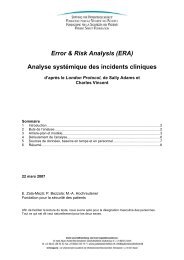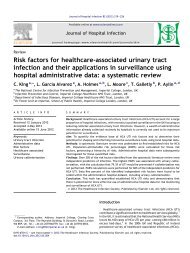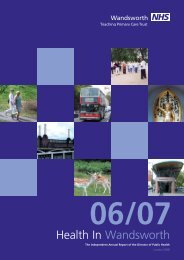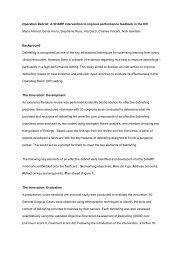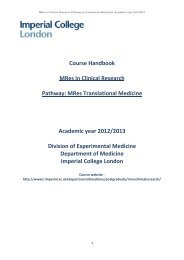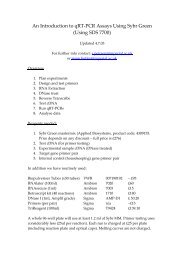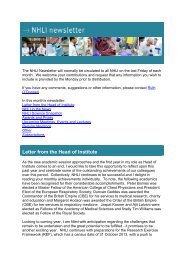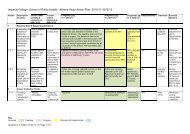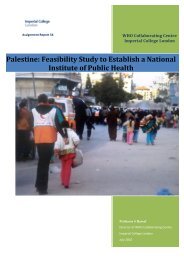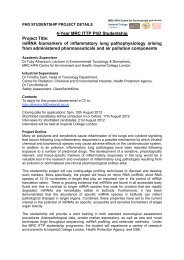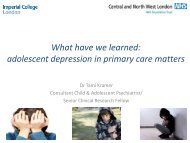2009 Annual Report - Imperial College Faculty of Medicine ...
2009 Annual Report - Imperial College Faculty of Medicine ...
2009 Annual Report - Imperial College Faculty of Medicine ...
- No tags were found...
Create successful ePaper yourself
Turn your PDF publications into a flip-book with our unique Google optimized e-Paper software.
6. WHO SUPPORT TO THE CENTRE6.1. The WHO Eastern Mediterranean Office supported the Centre during its first andsecond years <strong>of</strong> designation through various contractual or Agreement <strong>of</strong> Performance(APW) including:6.1.1. Provision <strong>of</strong> the Centre with videoconferencing system for educational exchangewith countries inside and outside the Region (already reported in first report 2007-2008).6.1.2. APWs for short-term WHO expert / consultant contracts to advise countries andWHO meetings and experts consultations6.1.3. APW on Capacity Building in Primary Care & MoH Malaysia (on-going) (WPRO)6.1.4. Development <strong>of</strong> ‘Staying Healthy’ Programme addressing non-communicabledisease risk factors (on-going)6.1.5. Provision <strong>of</strong> WHO publications6.2. Useful education and training tools have been developed and utilized by theCollaborating Centre in many countries around the world, especially developingcountries which provide services on the basis on demand rather than their population’shealth needs. These tools include:6.2.1. Health Needs Assessment (HNA) Tool: Based on the Ten-Steps Methoddeveloped by Rawaf and Marshall (1999), this practical public health tool, designed forprimary care-led services in countries with less reliable data on population, diseasedemographics or activities, provides evidence about a population on which to planservices and address health inequalities.6.2.2. Health Impact Assessment (HIA) Tool: The impact <strong>of</strong>decision/actions/policies/laws on the health <strong>of</strong> any given population is not wellpracticed in most countries <strong>of</strong> the world. This is largely due to lack <strong>of</strong> expertise and thenon-availability <strong>of</strong> training courses. The health <strong>of</strong> a community is determined not onlyby the health <strong>of</strong> its services, but also and more importantly by a wide range <strong>of</strong>environmental, social, economic, political and psychological factors. The use <strong>of</strong>prospective HIA is vital to minimise the impact <strong>of</strong> potentially negative decisions on thehealth <strong>of</strong> a population. This step-by-step approach and useful training tool is used indeveloping the capacities <strong>of</strong> national health systems.7. RECOMMENDATIONSHaving recently relocated to the Department <strong>of</strong> Primary Care and Public Health, theWHO Collaborating Centre for Public Health Training and Education will be leading onthe development <strong>of</strong> effective primary care and public health delivery.WHO CC ICL UK ANNUAL REPORT 2008 | 09 20



